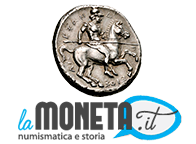Cerca nel Forum
Risultati per Tag 'aboukir'.
Trovato 1 risultato
-
Pseudo-medaglioncini di Aboukir?(Koinon) da Tkalec
cliff ha aggiunto un nuovo link in Monete greche: Grecia
Pubblico qui queste strane "monete" comparse nell'asta Tkalec che si teneva oggi. Vengono attribuite a Koinon di Macedonia e al periodo di Caracalla e Filippo I (III Sec. d.C.). Sarebbero quindi provinciali romane ma vista la fattura e le legende a me sembrano piu' monete greche a tutti gli effetti per cui apro qui la discussione. Non capisco d'altronde come facciano a ricondurle al periodo di Caracalla a parte per associazione al culto di Alessandro Magno promosso da questo imperatore e per la (vaga) somiglianza con i medaglioni di Aboukir che li contraddistingue. Essendo pezzi mai visti prima e riportati come unici ed inediti e provenienti da "collezione americana" vanno ovviamente presi con tutte le cautele del caso. Li riporto qui perchè il catalogo Tkalec non è molto fruibile e presto lo toglieranno da internet. Koinon of Macedonia. Pseudo-autonomous issue. Time of Caracalla (198-217) AV-Medallion, 3.50 g., 14 mm. Mint(?), 198-246. Obv.: Diademed head of Alexander the Great r. Rev. ΑΛΕΞΑΝΔΡΟΥ Athena seated left, holding Nike. Karsten Dahmen, “Alexander in Gold and Silver: Reassessing Third century AD Medallions form Aboukir and Tarsos,” American Journal of Numismatics 20 (2008), pp. 493-546, no. 15 (the silver medallion in Frankfurt). See fort the similar specimen of AV- Gold medallion (only 1.48 g,): Triton XVI, Lot: 690. Sold for $7000. USA private collection. Some minor marks. Unique. Extremely fine The small AV-Medallion is part of a larger series that includes the superb examples from Aboukir and Tarsos and related smaller specimens of various sizes in gold and silver. Many bear images of Alexander the Great, along with a series of mythological scenes. Some of these devices are also found on the autonomous bronze coinage of Macedonia of the early third century, suggesting the medallions might also have been made there, perhaps for distribution at the games in honor of Alexander the Great instituted by Caracalla. Caracalla himself is depicted on several of the Aboukir medallions, and it is likely that at least some were struck during his reign. Others may have struck as late as the reign of Philip I. This unique medallion, with the head of Alexander and a seated Athena, recalls the coins of Lysimachus. A second example in silver, from different dies, is in the Historisches Museum in Frankfurt am Main. Starting Price CHF 5000 Koinon of Macedonia. Pseudo-autonomous issue. Time of Caracalla (198-217) AR-Medallion, 1.2 g., 12 mm. Mint(?), 198-246. Obv.: Diademed head of Alexander the Great r. Rev.: ΠΕΡΓ… (a name, Pergamos?). Blank, with graffito. See Dahmen, nos. 2-3, for uniface gold medallions with the head of Alexander, and nos. 17-37 for silver examples similar to this. USA private collection. Some minor marks. Extremely rare. Almost extremely fine Like the previous example, this little AR-Medallion belongs to a group struck in both gold and silver of various sizes in the early third century AD. The portrait of Alexander, either diademed or with lion’s skin, is the most popular obverse type. Several other examples are uniface like this specimen, although typically the reverse shows a walking lion. Style of Alexander head is similar to the previous Medallion . Dies were engraved from the same hand. Starting Price CHF 1000 Koinon of Macedonia. Pseudo-autonomous issue. Time of Philip I (244-249) Gilt-silver medallion. 3.42 g., 18 mm. Mint(?) c. 244-249 AD Obv. Three-quarter facing gorgon head on aegis. Rev. ΦΙΛΙΠΠΟΥ Panther or lioness walking r. USA private collection. Gilt partly removed. Some minor marks. Unique. Almost extremely fine This small medallion also belongs to the same series. The facing gorgon head in fine style is similar to the facing head of Alexander the Great on several of the Aboukir medallions. The walking panther is related to the more common walking lions found on the small medallions. One of the Aboukir medallions (Dahmen, G, in Lisbon) is inscribed ΒΑCΙΛΕΩΝ ΦΙΛΙΠΠΩΝ, “of the kings Philip”, in the plural, possibly referring to Philip II and III of Macedon but, more likely, to the Roman emperors Philip I and II. This medallion, with the name Philip in the singular, likely refers to the emperor Philip I. Starting Price CHF 1000 Sicuramente dei pezzi particolari e immagino controversi, d'altronde si sono scritti fiumi di inchiostro sui medaglioni di Aboukir e Savio ci ha scritto anche un libro... Che ve ne pare?- 8 commenti
-
- medaglioni
- aboukir
-
(e altri 5 tag)
Taggato come:
Lamoneta.it
La più grande comunità online di numismatica e monete. Studiosi, collezionisti e semplici appassionati si scambiano informazioni e consigli sul fantastico mondo della numismatica.
Il network
Hai bisogno di aiuto?


